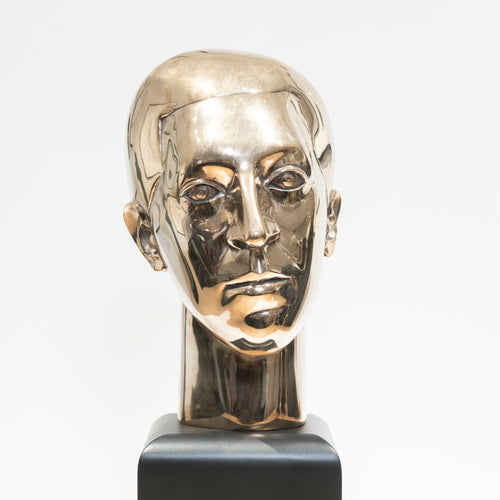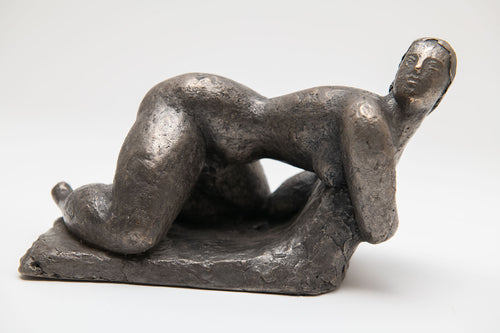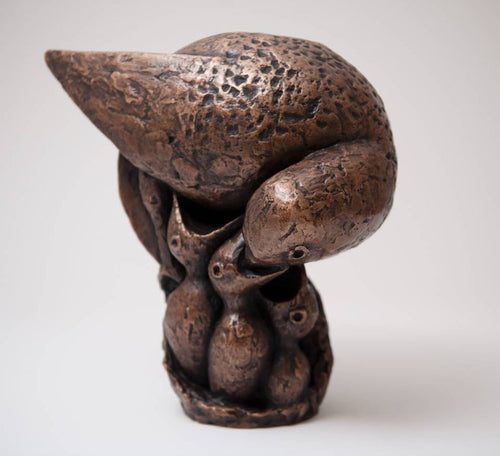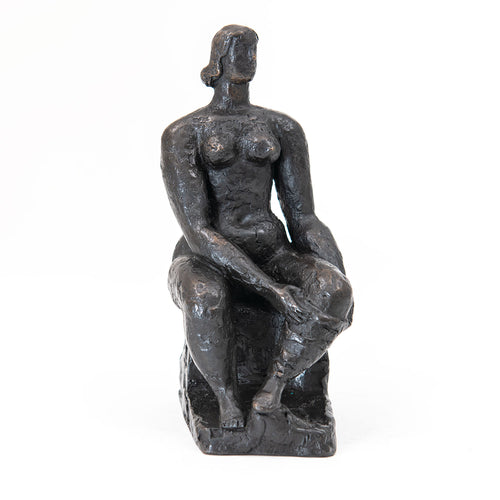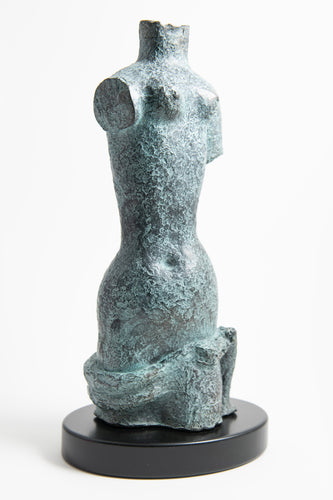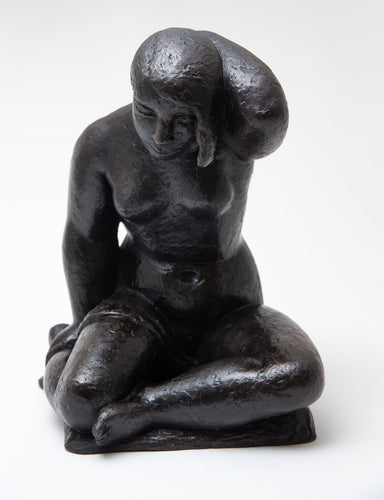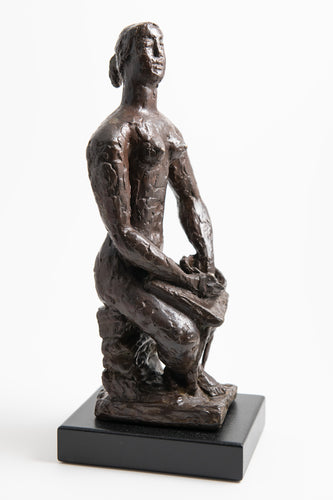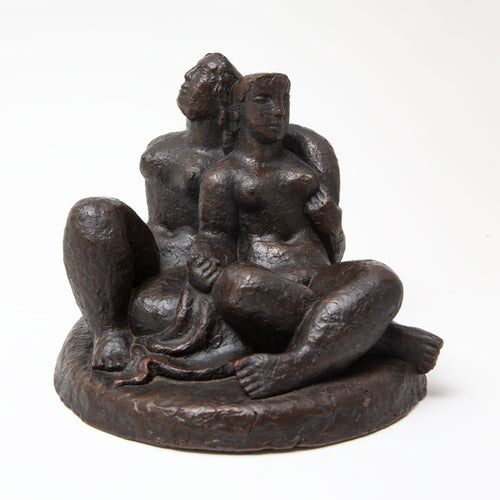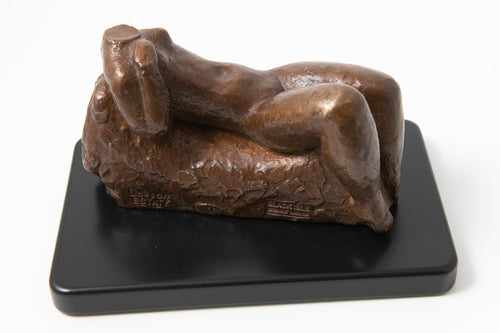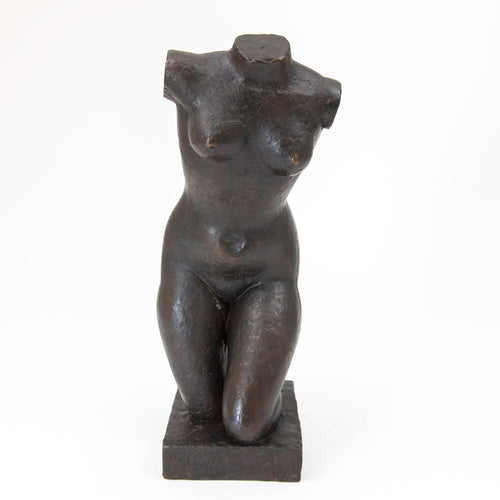To go alongside a past exhibition of Frank Dobson's work, we produced a detailed catalogue with an essay penned by the respected art critic Andrew Lambirth.
As a special preview for our Discover readers, we've decided to post the catalogue essay here alongside images of the work.

Frank Dobson 1886-1963
Frank Dobson was an immensely skilful and versatile artist, who started out as a painter in Newlyn, producing potboilers under a couple of pseudonyms. His achievement as a painter, from watercolour landscapes to portraits and work as a war artist, is little known and has been insufficiently studied. So it will be a revelation to many to see some of his more brightly coloured pastels and watercolours here.
 (above) 'Kneeling Woman with Bowl' (chalk); (below) 'Woman with Bowl' (chalk, left) and 'Romantic Drawing' (watercolour and gouache, right)
(above) 'Kneeling Woman with Bowl' (chalk); (below) 'Woman with Bowl' (chalk, left) and 'Romantic Drawing' (watercolour and gouache, right)

From 1915 he pursued his primary vocation as a sculptor with great verve and accomplishment, establishing a reputation as the leading English avant-garde artist in three-dimensions. He was one of the first great sculptors of the Modern Age in this country, but his achievement has been overshadowed by those who came after him - and in particular by Henry Moore.

 'Noni' (plaster)
'Noni' (plaster)
Although Dobson was widely acknowledged to be the successor of Gaudier-Brzeska, whose life was so tragically curtailed in the First World War, and although he enjoyed considerable success and wide acclaim in the 1920s and 30s, he was nearly 30 before he made his first serious sculpture, and nearly 40 before he properly hit his stride.
He was decidedly unfortunate in his timing. The War cut right across his development and delayed him by three or four years at a crucial point. (He enlisted in the Artists’ Rifles in 1915, saw action at the Somme and was invalided out of the Army in 1917. It took him time to recover.)
 (left) 'Woman with Towel' (watercolour and gouache); (right) 'Persephone' (watercolour and gouache)
(left) 'Woman with Towel' (watercolour and gouache); (right) 'Persephone' (watercolour and gouache)
Dobson, who was modelling whales out of dough at the age of five and loved messing around with engines, was clearly a practical man who needed to work with his hands. He soon discovered that painting and drawing, although agreeable activities, did not entirely satisfy his delight in physical processes. As he commented in 1933: ‘I found that in painting the results were achieved too soon’, and ‘the painting was done before I was.’

 'First Portrait of Auriol Salaman' (terracotta)
'First Portrait of Auriol Salaman' (terracotta)
He also said then (in a long dialogue broadcast by the BBC) that as far as he was concerned there was no difference between modelling and carving, apart from the medium, and that people should not dogmatise about stone-carving. Dobson was both carver and modeller, and his own versatility perhaps went against him in an age which valued specialism, and when the modellers and the direct carvers tended to be divided into opposing camps. Revealingly, he didn’t use his fingers to model, considering this to be too painterly a method, maintaining that it ‘starved’ the form. He preferred a slow build-up with tools - small wooden hammers and spatulas.
Interestingly, considering his superb command of technique, he had no formal training as a sculptor, though he did work as apprentice studio-boy to the decorative sculptor Sir William Reynolds-Stephens (1902-4). Yet the importance of his art school years should not be underestimated, for it was at Hospitalfield Art Institute in Arbroath (1906-10) that he began life-drawing, and at City & Guilds School in London (1910-12) that he continued his drawing studies.
 'Standing Woman' (left) and 'Standing Figure' (right, both sanguine chalk)
'Standing Woman' (left) and 'Standing Figure' (right, both sanguine chalk)
Life-drawing, and in particular the female nude, was always at the centre of his working practice. He admired the drawings of Ingres and the red chalk work of Watteau, Fragonard, Boucher and Alfred Stevens. In fact, Dobson’s own red chalk drawings (which he started to make in the 1930s) can be seen as a kind of two-dimensional counterpart to his terracotta sculptures.
 'Study for London Pride' (terracotta)
'Study for London Pride' (terracotta)
When beginning a sculpture, his habit was to make a small maquette in clay or wax to find the pose he wanted to use, then set up a life model in that pose and make dozens - sometimes hundreds - of drawings on which to base the final sculpture. In this way he could explore the composition thoroughly and assemble all the possible viewpoints of his figures into a continuous whole. Although the drawings were done to provide him with information to make sculpture, he also exhibited them, and from the start they proved popular.
 (above) 'Oast Houses' (watercolour and gouache); (below) 'Large Trees' (watercolour and gouache)
(above) 'Oast Houses' (watercolour and gouache); (below) 'Large Trees' (watercolour and gouache)

In the second decade of the 20th century, the rather insular English art world opened up dramatically. At Roger Fry’s two Post-Impressionist exhibitions, of 1910 and 1912, Dobson was able to see really good work by Matisse, Cezanne and Gauguin. He called the first show ‘an explosion’ and commented afterwards: ‘Anything was possible. Here was something more than just emotion. Here was work for the intelligence.’
He responded strongly to Cezanne, but it was Gauguin that sent Dobson to the British Museum to look at (in his own words) ‘Negro sculpture, Peruvian art, Egyptian, Assyrian, Polynesian, and - curiously enough, later - archaic Greek sculpture.’ He was also to be inspired by Picasso’s massive neo-classical figures and by Chinese art. The sculpture he made from the assimilation of such influences found favour with Fry and the other great formalist critic of the day, Clive Bell.
 (above) 'Reclining Nude figure' (bronze); (below) 'Rhoda' (bronze)
(above) 'Reclining Nude figure' (bronze); (below) 'Rhoda' (bronze)

In 1920, Dobson showed with Group X along with Edward Wadsworth, McKnight Kauffer and William Roberts - in Wyndham Lewis’ post-war attempt to revive Vorticism. Lewis suggested Dobson make his work more angular and pointed, but this was not his style and he didn’t comply. He was not particularly involved with the machine aesthetic, favouring a profoundly humanist approach, despite his interest in Cubism.
In later years his experimental approach calmed into a beguilingly nuanced classicism, and it is for this that he is best known. By 1924 he was chosen (along with Gaudier) to represent British sculpture at the Venice Biennale, and his work became famous in America, Italy, Belgium and especially Paris.

 'Squatting Female Figure with Pitcher' (bronze)
'Squatting Female Figure with Pitcher' (bronze)
Dobson is celebrated for his rhythmic treatment of mass and volume, for the grandeur and complexity of his figure subjects, for their monumental architectural quality. He dealt in essential forms - distilled shapes - evoking round-limbed and broad-thighed women, as if made for motherhood. He captured in them a sense of movement in stasis, a continuous rhythm that flows through these finely rounded bodies. Besides these archaic goddesses, Dobson made portrait busts. His portraits were proper pieces of sculpture (not just an academic fee-earning exercise) which also aimed for that most demanding of qualities: a likeness of the sitter.

 'Lady Dorothea Ashley Cooper' (bronze)
'Lady Dorothea Ashley Cooper' (bronze)
In the proposed Venice Biennale of 1940, cancelled because of the Second World War, Dobson was once again chosen to represent British sculpture. But by 1948, the time of the next Biennale, the tide had turned and Henry Moore was selected. Dobson had just been appointed Professor of Sculpture at the Royal College of Art (1946-53), a post for which he was recommended by Moore. This has often been seen as an act of support and generosity, but was it not also a way of keeping Dobson out of the limelight - by giving him a demanding teaching post to fulfil?
Artists are not always generous in acknowledging influence among their near contemporaries. Both Moore and Hepworth owed a great deal to Dobson’s trail-blazing treatment of the nude. Neither said very much about him, although Ben Nicholson cited Dobson along with David Bomberg as an early influence - the only two artists then working with what he considered a ‘universal outlook’.

 'Study for London Pride' (bronze)
'Study for London Pride' (bronze)
That universality can be seen in perhaps Dobson’s most famous sculpture, London Pride on the South Bank near the National Theatre, made for the 1951 Festival of Britain. It can also be seen in his more intimate drawings and sculptures of the nude, with their dignity and serenity, and their warming Mediterranean paganism.
 Dobson Estate stamp on the base of 'Squatting Female Figure with Pitcher' (bronze)
Dobson Estate stamp on the base of 'Squatting Female Figure with Pitcher' (bronze)
Did Frank Dobson want the mantle of avant-garde sculptor which was draped around his shoulders after the early death of Gaudier? In 1922, Ezra Pound (who had written the first book on Gaudier) introduced Dobson to Hemingway as ‘the saviour of sculpture in England’. That can’t have been a great help. In fact, although he enjoyed his moment of fame, Dobson was not cast down by his later eclipse. He found contentment in his work, and in his identity as a sculptor. That identity is once more of tremendous interest to us.
Andrew Lambirth
Andrew Lambirth (born 1959) is a writer, critic and curator. He has written on art for a number of publications including The Sunday Telegraph, The Spectator, The Sunday Times, Modern Painters and the Royal Academy magazine. Among his many books are monographs on Craigie Aitchison, Roger Hilton, Maggi Hambling, John Hoyland, Margaret Mellis, Allen Jones, LS Lowry, RB Kitaj and Francis Davison. His reviews for The Spectator 2002-2014 have been collected in a paperback entitled 'A is a Critic'.

